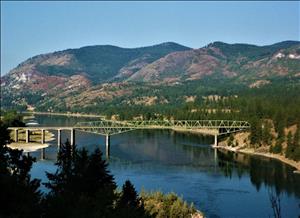On June 13, 1951, the Northport Bridge, spanning the Columbia River near the Canadian border in Stevens County, opens to motorists. The bridge carries State Route 25 across the great river and constitutes the farthest-north crossing within Washington state. Specially designed to withstand severe flood conditions, the steel cantilever through-truss bridge is the largest human-made structure in Stevens County.
First a Railroad Bridge
The first bridge built at this location was the Red Mountain Railroad Bridge, built in 1897 to serve the smelter that boomed the town of Northport for a time. Later this timber-trestle bridge was converted to accommodate auto and truck traffic. It was in use until October 1946, when it was deemed unsafe for traffic and closed.
The state awarded a contract to build a steel replacement span in August 1946. Construction began but the great spring flood of 1948 undermined the bridge before it could be completed. The contractors redesigned the structure to withstand flooding, using new underwater blasting techniques to build much deeper piers.
A Flood-Proof Bridge
The Northport Bridge is a riveted steel cantilever through-truss bridge. It has a 224-foot suspended span, two 140-foot-long cantilever spans, and two 168-foot-long anchor spans. Reading this from one side to the other the bridge is constructed in the following order:
- anchor span (168 feet)
- cantilever span (140 feet)
- suspended span (224 feet)
- cantilever span (140 feet)
- anchor span (168 feet)
As Craig Holstine and Richard Hobbs describe the structure in Spanning Washington:
"The truss sections have a horizontal top chord and lower chords, while the anchor and cantilever arms have sloping bottom chords. Its design, able to withstand extreme flood conditions, makes it ... one that residents can rely on for decades into the future" (Spanning Washington).

